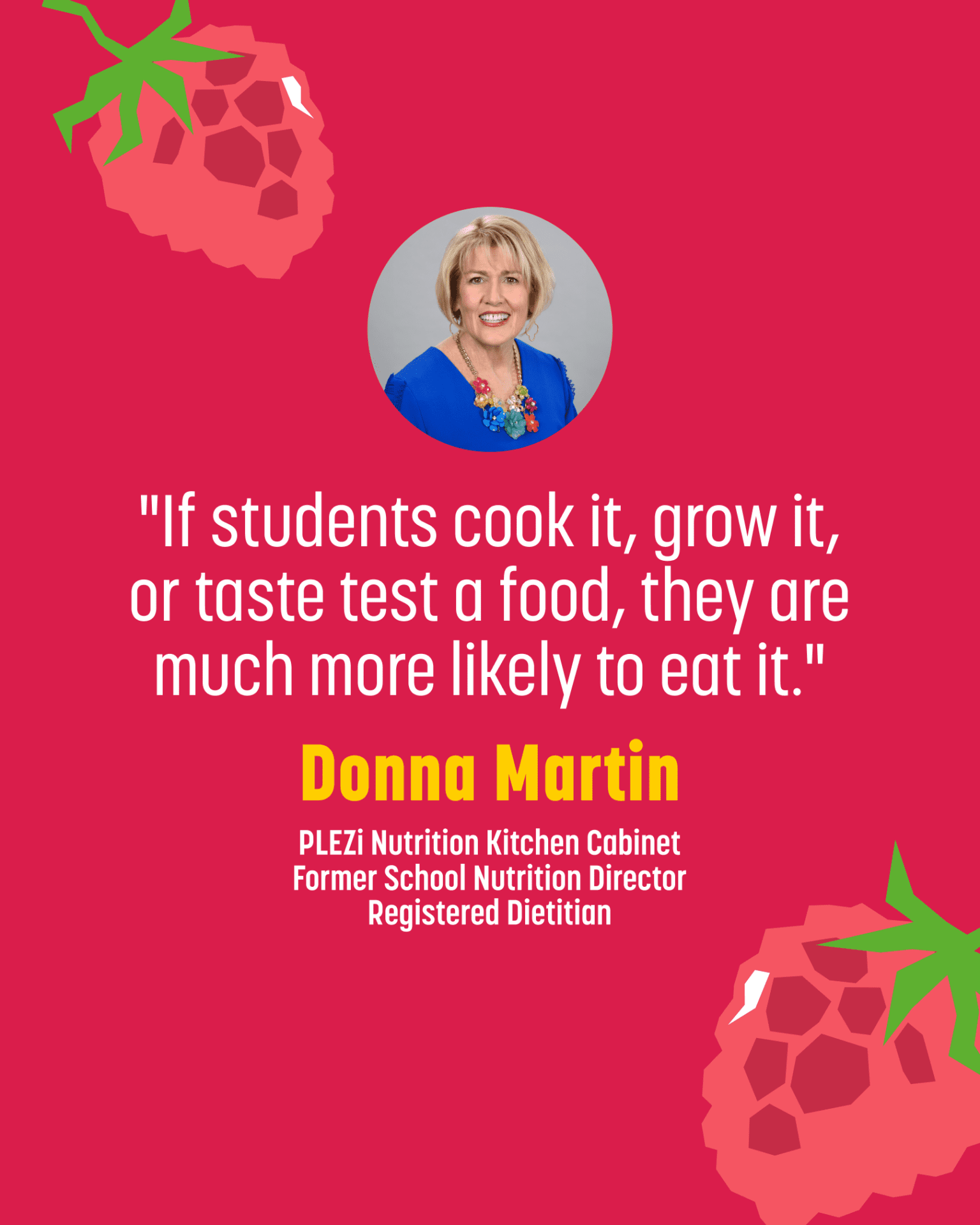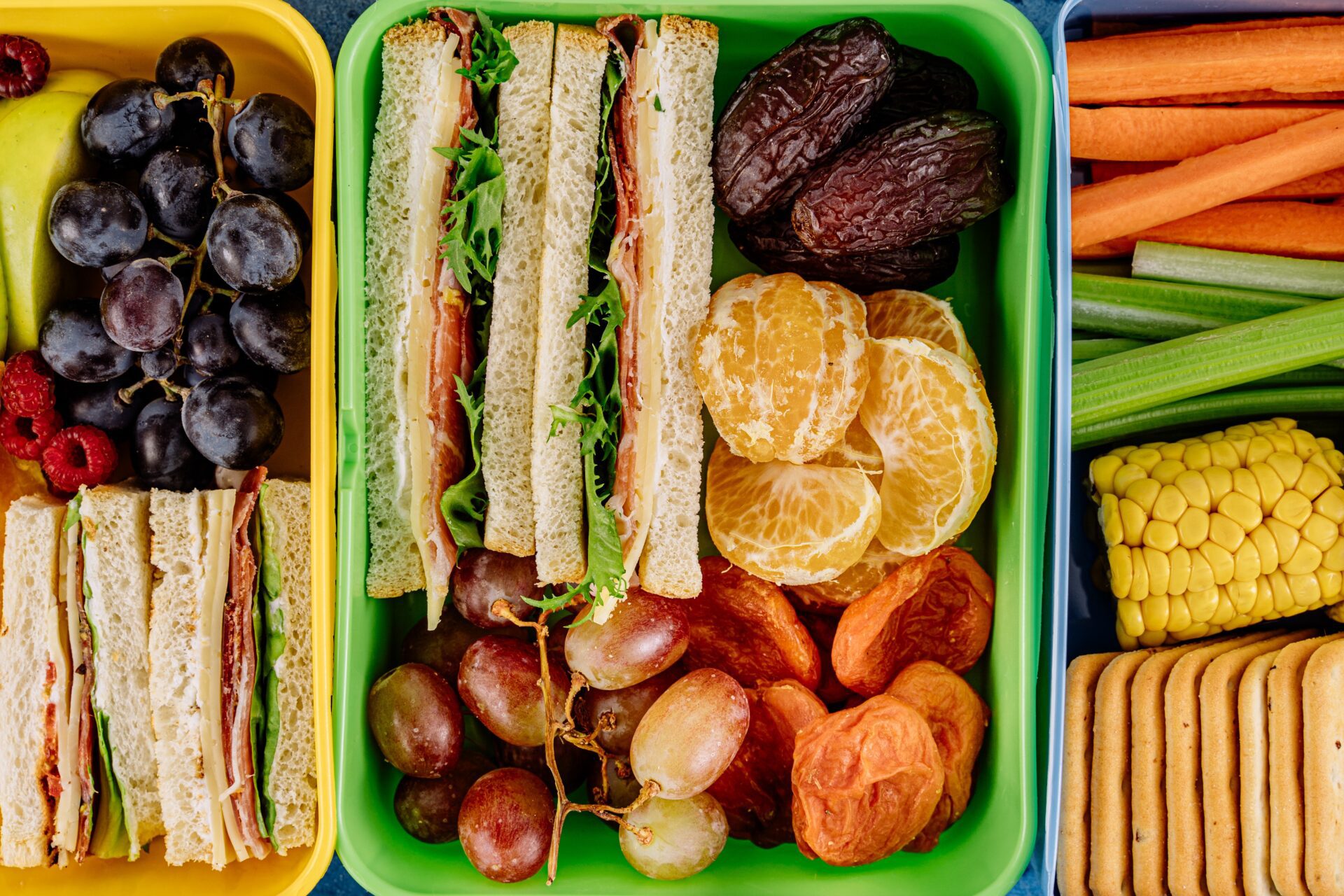Meet Donna Martin, PLEZi Nutrition Kitchen Cabinet Member, Registered Dietitian, and school nutrition expert. Donna recently retired from her role as the Director of the Burke County School Nutrition Program in Georgia, concluding a 32-year career in school nutrition. Donna, a Registered Dietitian Nutritionist, was the first School Nutrition Director to serve as President of the Academy of Nutrition and Dietetics, where she also held other leadership positions. We are thrilled to have her here for a Q&A.
To kick off our new series Table Talk, we invited our IG community to ask Donna any and all questions about children’s nutrition. Read on for Donna’s insights, check out her in-the-moment video replies over on IG, and feel free to DM us your questions over at @plezinutrition!
Q: My kids are so picky! How can I help encourage them to try new foods?
Donna: It sometimes takes 10-15 tries of a new food for kids to like the new food. I love giving them a choice of two new foods and asking them to choose which one they want to try. I also like the idea of having a “try new food chart” that they get to mark off each time they try a new food. Then when they have tried maybe 10 new foods you give them a reward that you agreed upon in advance.
I know that using a dip or sauce can make it a lot more palatable for the child to try new food. Maybe honey mustard sauce or even ketchup. Let the child choose the dip or sauce. Children love to model what their parents do so eating the item and talking about how delicious it is might help encourage them to try it. Offering the new food with different preparation methods such as roasted broccoli, raw broccoli, or steamed broccoli with cheese sauce might help. Be positive and do not get upset because it could lead them to dislike the food.
Q: Is it okay to reward kids with sweets for eating veggies? Thoughts?
Donna: I personally do not like rewarding children with sweets for eating vegetables because it leads to children overeating sweets and interferes with their natural ability to regulate eating. I instead like to reward them with something like stickers, a trip to the library or zoo, reading an extra book at bedtime, playing a game with their parents, getting to stay up 15 minutes past their bedtime, new coloring books or pencils, or having a playdate with a friend.
Q: What is more important to pay attention to: total sugars or added sugars?
Donna: It’s important to focus on added sugars. Total sugars are not the best way to measure your kids’ sugar intake because total sugar includes naturally occurring sugars in foods like fruit or dairy products. Naturally occurring sugars are digested differently by the body and do not normally cause a spike in blood glucose like added sugars. Spikes in blood glucose over time can lead to health issues like obesity, diabetes, and heart disease. Naturally occurring sugars found in foods like fruit and dairy have complementary macronutrients like fiber, protein, or fat which helps to better control blood sugar. (Editor’s Note: More about sugar here.)
Q: Advice for helping kids pick the “right” foods in the cafeteria? I worry that my daughter is choosing chocolate milk every day!
Donna: To be honest all school meals are healthy, so whatever meal your child likes at school, it is going to be good for them. School meals have very rigorous standards that must be met, which include more whole grain foods, low fat, increased fruits and vegetables, low sodium, low fat dairy, fewer desserts, and reduced calories. They are the only meals that have improved kids’ Healthy Eating Index score over the last 10 years.
When it comes to chocolate milk, it’s good to remember that milk provides some very important nutrients that children tend to fall short of, including calcium, potassium, and Vitamin D. Chocolate milk has also improved over the years. It used to have up to 25 grams of added sugar in it and now it has about 8 grams of added sugar. I think chocolate milk delivers “stealth health” and it is perfectly OK for children to drink it as part of school lunch once they are in kindergarten. The average flavored milk only has about 122 calories (only 25 more than white milk). A lot of studies have shown that if schools did not offer chocolate or other flavored milk children would not drink milk at all.
Q: How can I balance healthy vs. tasty when packing my kids lunch?
Donna: Here are some tips:
- Include a variety: Think about lunch as 50% fruits and vegetables, 25% lean protein and healthy fats, 25% starch or whole grains and fluids.
- Cut up fruit: Cutting up whole fruit like apples and oranges will go a long way to make sure they are eaten.
- Dip for veggies: Sending a dip (low-fat dressing, hummus, etc.) can help increase the chance kids will eat their vegetables.
- Something familiar: Include one item you know your kids are excited about.
- Involve your kids: Encourage them to pick a few items to go into their lunch box and you pick a few items
- Make it fun and personal: You can use a cookie cutter to cut sandwiches into interesting shapes. I always liked to include a napkin with a sweet note to the child in the lunch box to give them something to look forward to at lunch.
Don’t forget school lunch is also a great option! I encourage parents not to make children’s lunches because the school lunch program serves healthy meals for children.
Q: How do you get kids to be interested in cooking their own food?
Donna: I think the key to getting kids interested in cooking their own food is to start them out young. They can do easy things like wash vegetables, stir batter, and measure and dump in ingredients. Let them pick out a recipe they want to make so they can develop some confidence. Maybe make a yogurt parfait or a smoothie. Start them out cooking their favorite foods so they will be more excited about cooking something even if it is cooking dessert. If your child has to pack a lunch, you can teach them how to make a sandwich. Giving your child their own apron, oven mitts, and some smaller sized cooking utensils might be just the thing to get them interested in cooking. If you are watching a cooking show, you might ask your child to watch with you. Having a garden would definitely get them interested in cooking. When they are growing something like peppers or tomatoes, they can be incorporated into meals you’re cooking together. Having a family cooking competition might peak their interest also.
Q: How do you feel about dessert as an everyday thing vs. a special treat?
Donna: I think you can do different things as dessert for kids so it becomes more acceptable and not a total sugar load. Fresh strawberries, frozen yogurt, vanilla wafers, graham crackers, ginger snaps, animal crackers, fig newtons, dried fruit, trail mix, mandarin oranges and lower fat ice creams can be daily “treats” without all the added sugar. I certainly would not be allowing children to eat any sweets after dinner if they did not eat a great meal. Children might eat a dessert even when they are not hungry, which does not teach them to listen to hunger cues. If a child eats healthy all day, then having a little treat after dinner might be more appropriate than a child who does not eat healthy. Make sure the size of the treat fits the size of the child. Small children need small portions, and really small children don’t need dessert at all!
Q: How do you motivate yourself to keep up the good fight for kids’ health?
Donna: It is not hard to motivate myself to fight for kids. They are our future and teaching them to eat healthy is a great way to ensure their future is bright. We now know from studies that for children to do well academically, they need to eat healthy food, not just empty calories. Children are not born knowing how to eat, and it is our responsibility as adults to teach them how to eat healthy and why it is important.
For schools to serve the healthiest meals that are appealing to children they must have adequate funding, so I love advocating with Congress to make sure they know what is at stake in terms of feeding children. I love teaching School Nutrition Directors how offering more farm to school products can be a win-win for students, farmers, and the community. I know that if we can teach children how to cook, that they will become better eaters for the rest of their lives.
I am committed to a brighter future for our children through good nutrition and am willing to sing it from the rooftops if that is what it takes to ensure all children have access to good nutrition.

We’re so thrilled to have Donna on PLEZi’s Kitchen Cabinet – stay tuned for the next edition of Table Talk! And if you have more questions about nutrition, send us a message on IG @plezinutrition.

